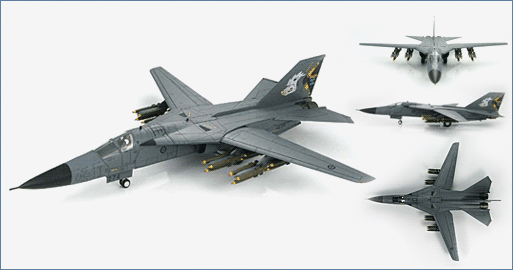Some of the best models of
F-111s I’ve ever seen are die cast models produced by a company called Hobbymaster from Hong Kong. Hobbymaster produces eleven different F-111 models,
which are part of their 1/72nd Air Power Series. These model F-111s
range the gamut from Royal Australian Air Force F-111s, and United States Air Force F-111s
from T.A.C. (Tactical Air Command), U.S. Air Forces In Europe and
FB-111As from S.A.C. (Strategic Air Command). The Air Power Series has other scales
including 1/32nd, 1/48th, and 1/444th. Hobbymaster also features other die cast
models in their Ground Power Series and Airliner Series. Although, the die cast
F-111s retails between $70-$90 each, which I find exorbitant, I’ve been told that
their craftsmanship and quality are justifiable. This post on this blog does not constitute an official endorsement of Hobbymaster.
 |
| United States Air Force F-111A 474th Tactical Fighter Wing, Thailand in 1972 |
 |
| Royal Australian Air Force F-111C “Pig” No.6 Squadron, No.82 Wing, "A8-127" |
 |
| United States Air Force EF-111 Raven 42nd Electronic Combat Squadron, Royal Air Force Upper Heyford, United Kingdom 1989 "LET'EM EAT CROW" |
 |
Royal Australian Air Force F-111G "A8-274 “60th Anniversary of Number 6 Squadron, July 1999 |
 |
| United States Air Force F-111G "69-6506" 428th Tactical Fighter Training Squadron, 27th Tactical Fighter Wing, Cannon Air Force Base, New Mexico |
 |
United States Air Force FB-111A "AARDVARK" 68-0271, 509th Bombardment Wing,
Pease Air Force Base,New Hampshire 1974
"New Hampshire Special"
|
 |
United States Air Force F-111F "70-2390" 48th Tactical Fighter Wing, Royal Air Force Lakenheath, United Kingdom. (CO., Nov 1991) |
 |
Royal Australian Air Force F-111 A8-125, "Final Flight"
|
 |
| United States Air Force F-111E "Aardvark" 68-0049, 79th Tactical Fighter Squadron, North Atlantic Treaty Organization Tiger Meet, 1991 |
 |
United States Air Force F-111E Aardvark "The Chief" 68-0020, 20th Tactical Fighter Wing, Royal Air Force Upper Heyford, United Kingdom. (Flagship, 1989)
|
 |
Royal Australian Air Force F-111C PIG A8-148, No. 1 Squadron, (camouflaged scheme) |




